The earliest messiahs, gods and goddesses on every continent were woolly haired Black people. Historian Sir Godfrey Higgins wrote, “The originals of all the Gods have been of the Black race”.
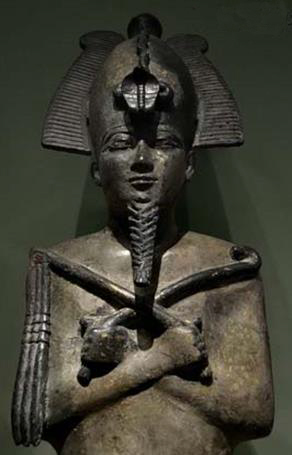 The ancients viewed the sacred image of the Divine as Black and woolly haired, which was referred to as the hair of the gods and a sign of divinity.
The ancients viewed the sacred image of the Divine as Black and woolly haired, which was referred to as the hair of the gods and a sign of divinity.
Below is a partial list of some of these Black Deities.
• Osiris (Asar/Ausar/Asa), the husband of Isis (Auset/Ast), (left) was sun-rayed and Black with woolly hair and was also the greatest of the Egyptian gods who was known as The Great Black similar to Krishna’s title.
His chief title means Lord of the Perfect Black.
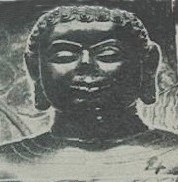 • Buddha of India was Black, and that is the reason his woolly hair is always shown in small tight curls as in corn rows. Early figurines of him depicted his Afrikan features with a wide nose and full lips. In the most ancient temples of Asia and India, the statues of the gods and goddesses have Afrikan features and woolly hair in pepper corn style or in dreadlocks.
• Buddha of India was Black, and that is the reason his woolly hair is always shown in small tight curls as in corn rows. Early figurines of him depicted his Afrikan features with a wide nose and full lips. In the most ancient temples of Asia and India, the statues of the gods and goddesses have Afrikan features and woolly hair in pepper corn style or in dreadlocks.
• Zeus, the top god and father of the gods in Greek mythology was naturally Black with woolly hair, since he originated from Afrika. His chief title was Ethiops, meaning burnt faced.
• Apollo was likewise Black and woolly-haired like his father Zeus. The world famous Apollo Theatre in Harlem was named after him.
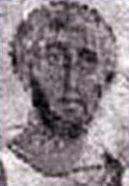 • Fu-Hsi (Xi), the Son of Heaven and the legendary first Emperor of China, was also Black with woolly hair.
• Fu-Hsi (Xi), the Son of Heaven and the legendary first Emperor of China, was also Black with woolly hair.
• Lao-tse of Taoism was born of a virgin, Black in complexion, and was described as marvellous and beautiful as jasper. Splendid temples were erected in his honour where he was worshipped as a god.
• Zaha of Japan was woolly haired and Afrikan in appearance.
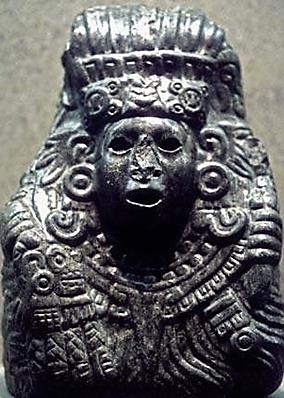 • Quetzalcoatl of Mexico was recognized as the Messiah by seers and astrologers; his head was rayed; his complexion was Black and his hair was woolly. Between the 14th and 16th centuries during the Aztec era, Quetzalcoatl was worshipped as the patron of priests, the inventor of books and the calendar, as well as the protector of goldsmiths and other craftsmen.
• Quetzalcoatl of Mexico was recognized as the Messiah by seers and astrologers; his head was rayed; his complexion was Black and his hair was woolly. Between the 14th and 16th centuries during the Aztec era, Quetzalcoatl was worshipped as the patron of priests, the inventor of books and the calendar, as well as the protector of goldsmiths and other craftsmen.
Quetzalcóatl was also looked upon as the symbol of death and resurrection. Contrary to statements made by the friars, he was never blond nor white.
• Ixliton is the name of a Mexican god, meaning Black faced. Many ancient Mexican gods are portrayed jet Black with Afrikan features.
• Dilyehe, meaning Home of the Black God, was the name that the Navajo gave to the seven suns of Pleiades.
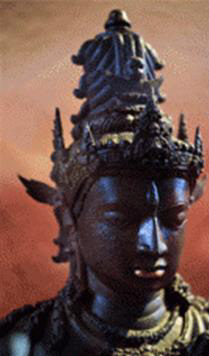 • Krishna of India (left image) whose name means Black or The Black One, was blue-Black and is always portrayed with either Black or blue skin and woolly hair which was sometimes shown in locks, according to the Cambridge Encyclopaedia. The gods of ancient India are usually shown wearing Ethiopian crowns on their heads.
• Krishna of India (left image) whose name means Black or The Black One, was blue-Black and is always portrayed with either Black or blue skin and woolly hair which was sometimes shown in locks, according to the Cambridge Encyclopaedia. The gods of ancient India are usually shown wearing Ethiopian crowns on their heads.
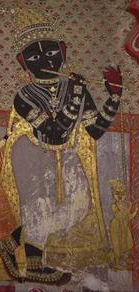 The Brahma Samhita is a Sanskrit text that is composed of verses of prayer glorifying the supreme Lord Krishna or Govinda at the beginning of creation.
Chapter 5 verse 38 reads: “I worship Govinda, the primeval Lord, …. and His bodily color resembles the color of a fresh black cloud, although His bodily features are more beautiful than millions of Cupids”.
The Brahma Samhita is a Sanskrit text that is composed of verses of prayer glorifying the supreme Lord Krishna or Govinda at the beginning of creation.
Chapter 5 verse 38 reads: “I worship Govinda, the primeval Lord, …. and His bodily color resembles the color of a fresh black cloud, although His bodily features are more beautiful than millions of Cupids”.
Chapter 6, verses 1-2 reads: “The Lord was dressed in yellow garments and had a blackish complexion”.
The Sanskrit word “Krishna” literally means “black,” “dark” or “dark-blue”. Krishna is also called “Śyāma,” "the blackish one", or "the beautiful dark boy with a blackish color".
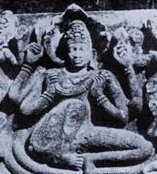
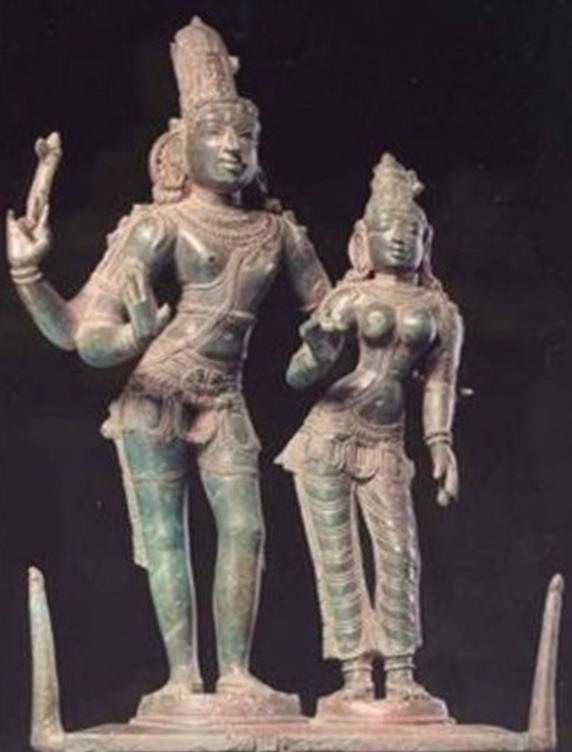 • Vishnu the Hindu god meaning all-pervasive in Sanskrit, (left) is the protector and preserver of the universe and even regarded as the supreme god by some Hindu.
• Vishnu the Hindu god meaning all-pervasive in Sanskrit, (left) is the protector and preserver of the universe and even regarded as the supreme god by some Hindu.
• Shiva, the husband of the mother goddess Parvati, (right) is the Hindu god of destruction and restoration whose aspect is usually terrifying, but can also be gentle.
• Tyr of Scandinavia was a woolly haired Norse god who preceded Thor as a sky deity.
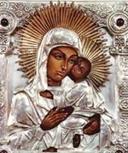 • Isis (Auset), the greatest of the Afrikan Goddesses was worshipped throughout the ancient world in Egypt, Greece, Rome and beyond. She was known as the Queen of Heaven and the Goddess from whom all up-and-coming arose. The worship of Isis survives today disguised as the worship of the Black Madonna throughout Catholic Europe.
• Isis (Auset), the greatest of the Afrikan Goddesses was worshipped throughout the ancient world in Egypt, Greece, Rome and beyond. She was known as the Queen of Heaven and the Goddess from whom all up-and-coming arose. The worship of Isis survives today disguised as the worship of the Black Madonna throughout Catholic Europe.
 • Venus of Willendorf is a famous statue of the Mother God as she was worshipped some 15 to 20 thousand years ago. although she is found in most art history books, there is no mention that she is Afrikan: her entire faceless head is covered with woolly hair like that of the Buddha.
• Venus of Willendorf is a famous statue of the Mother God as she was worshipped some 15 to 20 thousand years ago. although she is found in most art history books, there is no mention that she is Afrikan: her entire faceless head is covered with woolly hair like that of the Buddha.
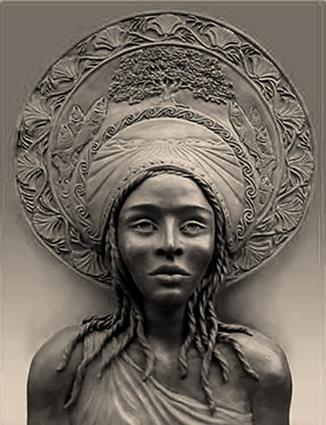 • Caillech (Cale, Kali) was known as the Black Queen in medieval legends, and to the Celts as the mother of many races.
• Caillech (Cale, Kali) was known as the Black Queen in medieval legends, and to the Celts as the mother of many races.
The Spanish called her Califia and gave her name to their newly discovered paradise which is now called California.
• Scotia was a Black goddess and Egyptian princess after which Scotland is named.
• Kali meaning the Black One was the Great Black Mother as well as the Hindu Triple Goddess of Creation, preservation, and destruction. She is also known as Kalikamata, Black earth-mother and Kalaratri, Black night, and among the Tamils she is known as Kottavei. Kali is worshipped particularly in Bengal and her best known temples are in Kalighat and Dakshineshvara.
• Nidra the sister of Vishnu, is a Black-skinned goddess who is clothed in yellow and dark blue silk.
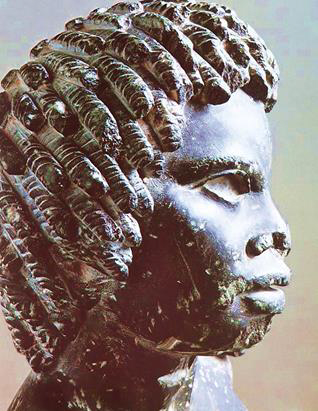 • Athena of Greek mythology was Black and woolly haired, originating from Libya, Afrika.
• Athena of Greek mythology was Black and woolly haired, originating from Libya, Afrika.
She was also known as Anath, Medusa, and the Egyptian goddess Neith.
She was later whitened like the other Afrikan gods when adopted by the Europeans.
• Kar of Afrika's Nile Valley was the inner soul of Mother Earth. She was a beautiful ebony virgin who was the Heart of the World. Shrines of Karnak in Egypt and Carnac in Brittany were dedicated to Kar who was the Goddess of Agriculture, especially grain. She was called Kore by the Arabs and Greeks, and Ceres by the Romans.
• Circe, who played a great role in Homer's Odyssey, was the most famous female magician of all time. Ancient Greek drawings portrayed her as a beautiful Afrikan woman.
At • Delphi in Greece, the oracles of Dodona and Apollo were founded by two Black Doves or Afrikan priestesses from Thebes, according to Herodotus.

© John Moore - Barbados, W.I. (March 2000) ©. All rights reserved.